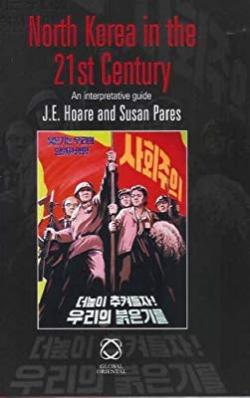North Korea in the 21st Century, An interpretative guide

Global Oriental, 2005, ISBN 1-901903-91-5 (Cloth), 1-901903-96-6 (Paperback), 253 pages (including index, references/bibliography and black and white illustrations).
Review by Sir Hugh Cortazzi
Dr Jim Hoare opened the British Embassy in Pyongyang, capital of North Korea, the Democratic Peoples Republic of Korea, in 2001 and was the first British diplomat and Chargé d’Affaires resident in Pyongyang. He and his wife Susan Pares, who accompanied him in Pyongyang and worked with the United Nations, have provided in this book a valuable introduction and guide to North Korea, which will be most useful for visitors and future foreign residents in a country about which so little is known in the West and which is generally referred to by various clichés
The first and most important part of the book, headed “Understanding the DPRK,” outlines the basic facts necessary to understand the nature of North Korea today. The first chapter entitled “Politics with North Korean Characteristics” describes the attitudes and methods employed by the regime. The authors point out that in North Korea (page 5) “what matters is not what you are now, but what your family once was. There is, in other words, no escaping one’s past.” The indoctrination process, the personality cult and the emphasis on conformity are explained.
The “labour camps” and the reports of human rights violations are described, as is the bizarre and ghoulish way in which the dead Kim Il Sung has been retained as President and who is “revered” in ways which make the cults of Stalin and Mao Tse Tung seem tame.
The book brings out the way in which history has been ‘interpreted’ to support the regime and the Confucian emphasis on loyalty and the relationship between rulers and ruled exploited. The North Korean slogan juche (self reliance) was first expounded by Kim Il Sung in 1955 and is reiterated endlessly in regime propaganda.
All the chapters in this first part covering the role of history, the rise and fall of the North Korean economy, society, cultural values and the outside world provide a succinct analysis of the country and its post-war history. Among the fascinating little nuggets in these chapters is a brief description of the Ryugyong hotel (page 46), known to Koreans as “the 105-storey building”, but never completed: “the vast pyramid crowned with a crane that has never been retrieved, now adds a surreal touch to the Pyongyang skyline” which foreign visitors are not supposed to photograph.
Another example of the peculiar ways of the regime is the fact that, although for a time mobile phones were allowed, in May 2004 “the right to use a mobile phone was withdrawn from all users, foreign and Korean.”
The authors in their accounts of the sorry state of North Korean agriculture and the decline of industry note that nonetheless real changes are occurring. Despite the continuing shortages of food, energy and clean water “North Korean society, at the start of 2005, is clearly in better shape than it was seven to eight years before.”
They note the limited development of a few markets and say (page 82): “The impression now is of a society that is becoming differentiated and unequal.” But the state remains ubiquitous and all powerful, as is clear from their comments on the state of religion and the arts in North Korea.
Since the late 1980s five churches have been or are being built in Pyongyang. “The initiative, attributed to Kim Jong Il, to construct an Orthodox church in Pyongyang and to provide it with a congregation illustrates the decisive part the state plays in religious affairs (page 90).”
The arts (pages 91/2) “are encouraged, not for their own sake or as an outlet for individual ability and sentiment, but primarily as an element in official policies.” “In few places has the subordination of intellectual activity to ideological considerations…become so entrenched as in the DPRK (page 110).”
In their chapter on “The Outside World” the authors trace the history of North Korea’s relations with the rest of the world and “the very limited exposure” of its diplomats to the world. This “produced a generation with great suspicion of outsiders and a dour and unyielding approach to negotiations (page 113).” The authors outline the development of relations with South Korea and give a fair, if brief, summary of the problems between North Korea and Japan.
Their account of the negotiations over nuclear developments is a useful analysis of a complex issue. Their conclusion, which is only briefly stated, is not one, however, which President George W Bush is likely to endorse: “More sensible than a confrontational and hostile approach is that one that draws the DPRK ever more into the wider world, and one that accepts that the North does fear a genuine threat from the massive armed forces of the United States (page 138).”
The second part entitled “Visiting and Living in the DPRK” is essentially a guide book to the country. It deals with everything from visas to hotels and restaurants, doing business in the country and places worth visiting. Some of these places sound as if they could be attractive to tourists if communications and hotels were drastically improved.
The third part entitled “A Brush with History” is an entertaining account by Jim Hoare of the difficulties and frustrating problems he encountered in opening the British mission in Pyongyang. Through patience and persistence he eventually got permission for the opening of satellite communications which he rightly considered essential in these days for the efficient conduct of diplomatic relations.

